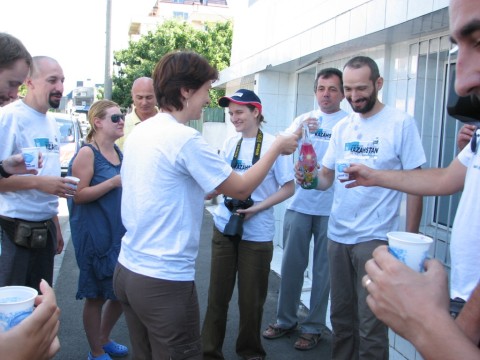
Photo by: Anca Munteanu
We were standing in the field, whipped by the freezing early morning wind, admiring a random display of off road skills. Next to us, dressed in ski clothing and prepared for everything, stood a thin man holding his cup of hot coffee with both hands. He was completely absorbed by the events taking place on the steep side slopes in front of us and, as I started to photograph one car or the other, we began talking. This is how I ment Vadim Bondar, one of the people who lead the scientific off road expedition onto the heart of Kazakhstan.
This small interview is aimed at depicting at least a small amount of the fascination I found myself experiencing with regard to their courage, team spirit and adventure cravings, as well as presenting the people rather than the adventure.
I will begin with the most obvious of questions: how did you get the idea for the expedition?
The majority of the people involved in this expedition are cavers, therefore people who have participated in various expeditions in other remote places of the planet. This time we had the chance to make use of the off road vehicles, so as to change the feel of the events for a little while. Concentrating on the fact that we can approach expedition destinations in a different manner due to the means of transportation, we decided to pick a destination that required the precise services of such vehicles but that would also present a strong scientific, cultural and social interest. We agreed that the Aral Sea would be one such destinations
How did you pick your vehicles? Were they your personal overlanders or did you chase up the cars that would best serve your purposes?
To be honest, it was the cars that chose us. The companies where some of us work agreed to borrow three off road cars equipped with everything for such a trip. In other words, we didn't really pick the cars, we took what was available to us. Unfortunately, on the last hundred meters, the Nissan Navara that was supposed to be the third convoy car became unavailable and we were left with two cars – the Nissan Terrano from Akita Adventure Team and a Suzuki Grand Vitara provided by Zebra 3.
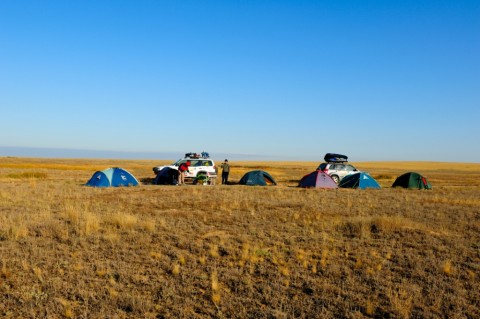
Photo by: Vadim Bondar
I presume you made a thorough research beforehand, documented yourselves and had a concrete image of each stage of your expedition. How different was the image you created from whatever actually took place during your three weeks?
Yes. We tried to outline a clear, well defined route of the environment but also of the socio-cultural medium. Unfortunately, the actual information regarding the vest of Kazakhstan are incredibly vague and self-contradicting.
Every now and again, the differences between theory and practice were huge, especially when the “official reality”, on paper, internet and maps, had absolutely nothing to do with the actual places. A concrete example was the E40 route, which finished at Aralsk – on maps it was written down with a red line. According to the map guidelines, it was supposed to be one of the high quality roads. Getting there, we found, 400 kilometers into the journey, that the main road simply vanishes. The 1000 remaining kilometers are roughly outlined though desert or the steppe.
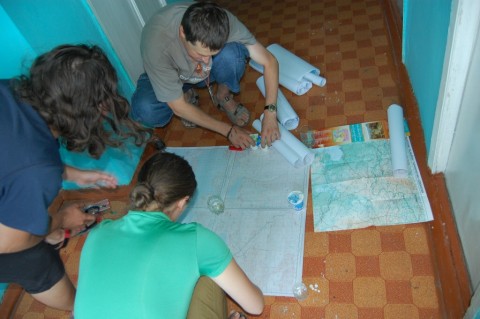
Photo by: Roxana Soreata
How did you manage to secure sponsors? I know you managed to attract big names, among which the corporate giants Nikon and BFGoodrich. Was it difficult to present a project that would be worth sponsoring?
The thing is that in these kind of situations, terms such as difficult, easy or facile are completely and utterly relative. It was easy to obtain the sponsor's support but putting together the core, the concept of the project as well as the way we were going to approach the issue was one of the very difficult parts. Also, I think that the excellent references we received from the Faculty of Geography- University of Bucharest, the National Geographic Romania Magazine, the Romanian Geographic Society, the "Emil Racovita" Insitutute of Speleology , the “Geomorphologic Dynamic and Terrain Degradation” Research Center, helped a lot.
How much time did the preparations take, from the first time the idea came to be, until the morning you left?
The idea came somewhere at the beginning of January 2009 and the departure took place on the 2nd of August, same year.
During the trip, how did you find the cars?
We were 5 people in the Terrano and 4 in the Suzuki. It was a little difficult but we pulled it off.
I noticed that, on longer trips, there is a tendency to burden the cars with all sorts of objects that prove to be useless. Looking back, how did you manage with the space you had available and did you actually carry any equipment that you found no use for?
There were a number of objects that we didn't use at all, but that we couldn't have left behind but we also had some that were not really necessary. You can't give up the second spare wheel, tools, accessories for recovery and various off road techniques, meds and poison extractors and so on. I think we could have taken a little less pots and pans though …
Which was your biggest problem on this route and how did you overcome it?
The biggest technical issue we were faced with was the point when one of the Nissan's bulbar handles broke off. We were very lucky that the bulbar didn't fall in front of the car during driving. We found a temporary solution with a drill hole and a few screws.
The other big issue we encountered was the moment when the sale bank on the Aral Sea shore broke off and both cars got stuck in the mud. The wheels were spinning helplessly in a black sticky clay and the vehicles' underbody was touching the ground. We managed to set them free, after 6 hours of hard work. The essential tools for doing this were the jerry cans and the air-jack we had. The cars were raised with the air-jack and the canisters were positioned under the wheels. Usually we would have used sand ladders but since we didn't have them, we made do with the available resources.
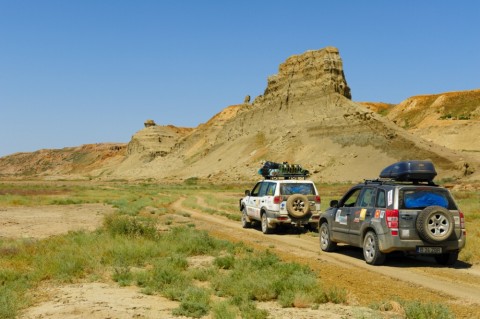
Photo by: Vadim Bondar
What surprised you most during this trip?
Somebody who's not accustomed to the desert or steppe landscape would have reasons to be surprised every step of the way. The ones who were familiar with this scenery can't help but enjoy the infinite plains, the smell of wormwood and the sand dunes.
How would you describe what was once the bottom of the Aral Sea? It's true that photographs are worth a thousand words but sometimes extra information can enhance the impact of the images.
The fact that one can be the witness to an ecological disaster of such a staggering caliber, which took place in the last 50 years, is a feeling in a class of it's own. The desert that is currently expanding over what was once a sea, sand dunes and camels with their lazy and confident walk, strolling among abandoned rusty ships creates a surreal scenery.
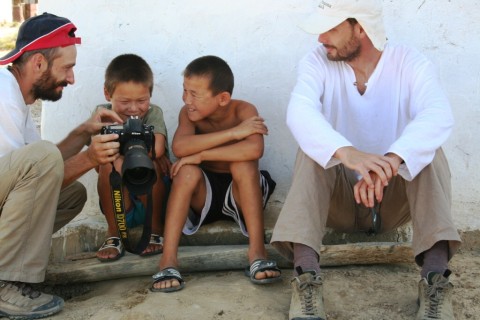
Photo by: Vera Darmiceanu
Will anyone be able to see your movie soon, or at least a trailer on the web? I know you are working on an English version of your blog?
We hope to sort these aspects out as soon as possible (editor's note: for anyone wanting to read or see the images, Google Translate does a pretty good job of turning the Romanian website into an English equivalent. Check it out at http://www.kazahstan2009.wordpress.com/)
Now that you're done with the trip, is there anything you would have done differently?
Taking into account the amount of information we had and budget at that time, I believe that we made the best of it. Still … I must admit that the decision to take nine people in 2 vehicles was a huge risk. In the extreme case of one car completely failing, the remaining vehicle would have been unable to accommodate the extra crew, not to mention the equipment. The comfort and car over-burdening is more than obvious. Also looking back at what we didn't have, I think that sand ladders would have been brilliant, would have saved us a lot of energy in the Aral incident. One of the last things I found was that, driving through these isolated regions, it's a good thing to have cars that match the local variety as much as possible.
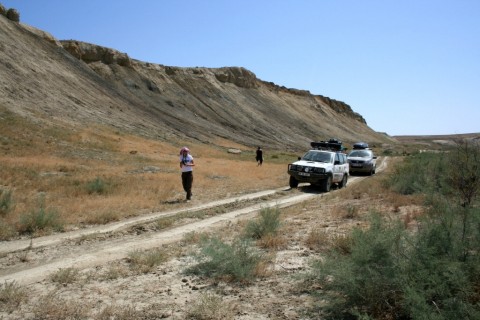
Photo by: Vera Darmiceanu
Do you think that you chose a difficult route? Would your recommend it to other overlanders?
From a route point of view, it's not a route with a high degree of difficulty. You can probably deduce that the cars we used were far from extreme class performers, not to mention the weight they had to carry. On the other hand it's most certainly an endurance track. Of the 3848 km we did in Kazakhstan, a lot over 2000 km were off road. Come to think about it, there were days when we drove 200-300 km through desert or steppe. It's very important that one drives carefully and protects the car.
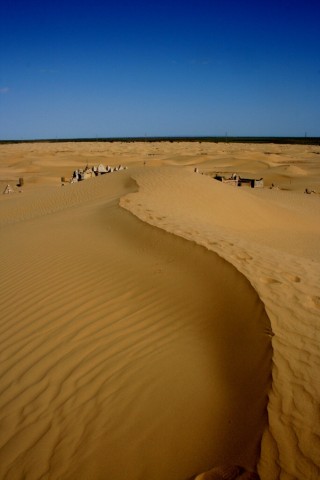
Photo by: Vera Darmiceanu
Considering the tourist aspects of the country, the eastern part is far more appealing and has the advantage of a better infrastructure. For rally raid lovers though, western Kazakhstan (The Aral Sea area, the Ustiurt plane, the Mangystau passing, etc.) can be one of the most attractive and cheap destinations.